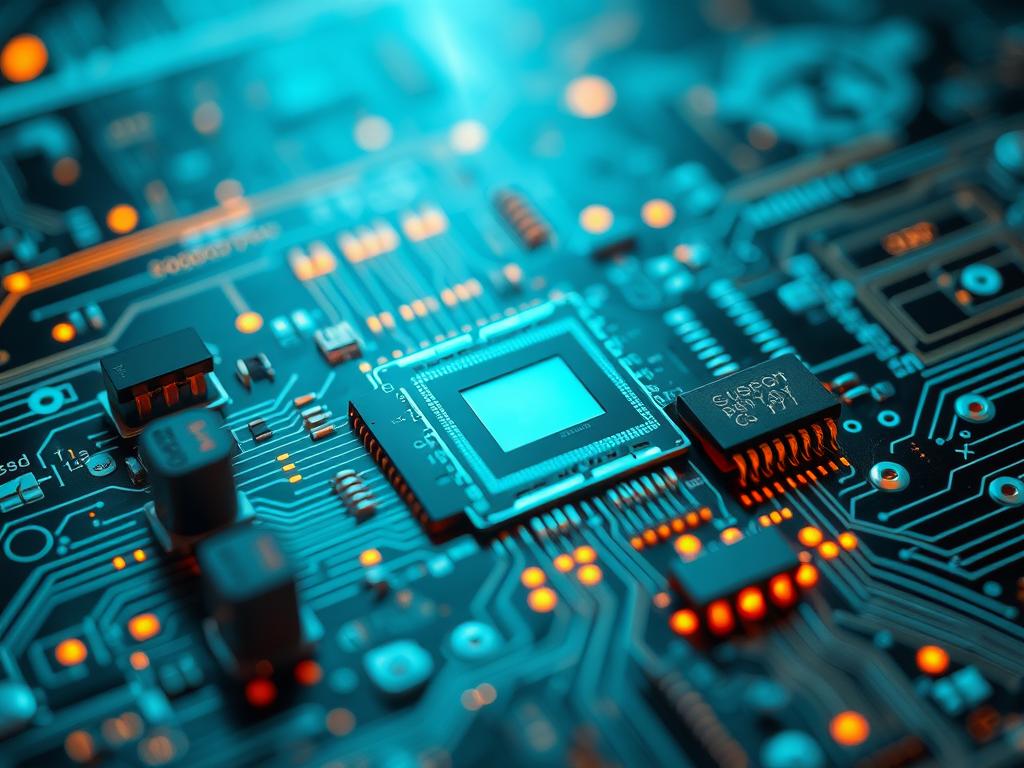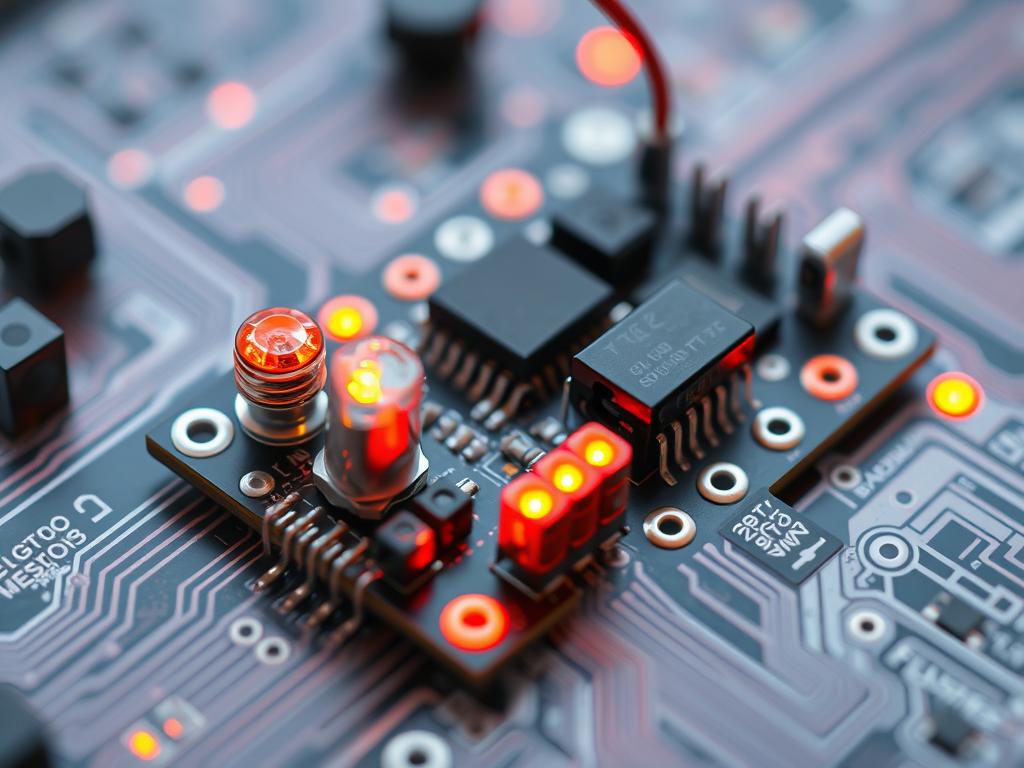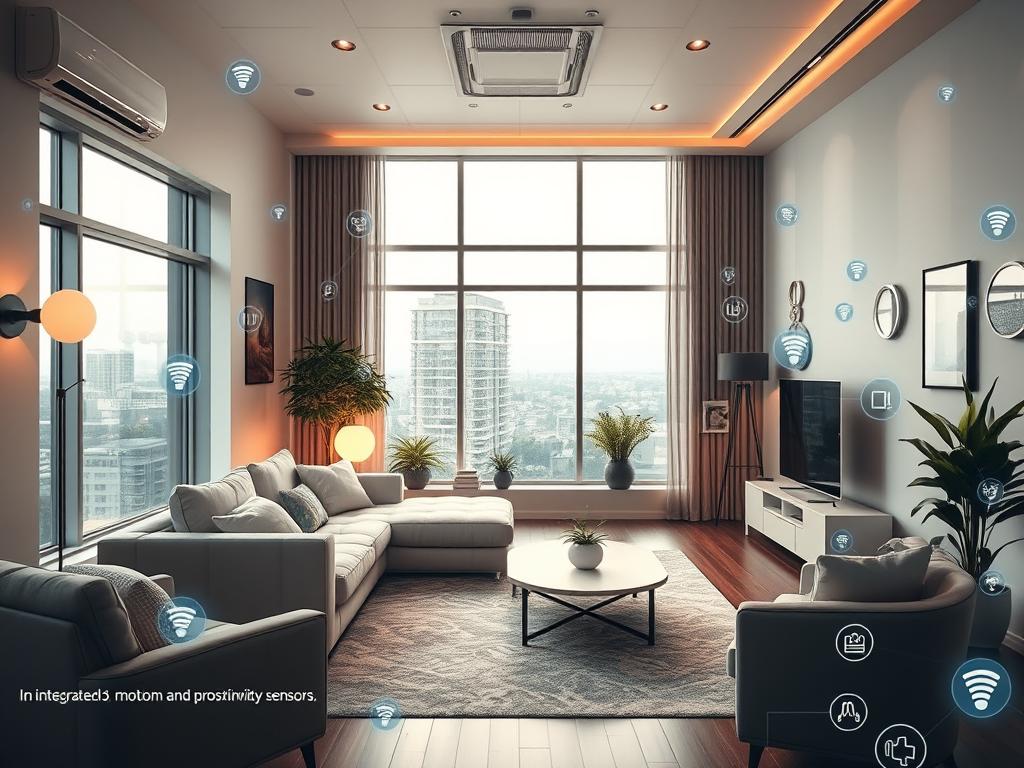Motion and proximity detection are key in today’s tech. They make systems safer, more efficient, and easier to use. Transistors help devices sense their environment by detecting objects without touching them. This is important in many fields, like gadgets, cars, and factories.
Transistors, like the BC547, are great for this job. They can handle up to 100mA of current and work with voltages up to 45V. They’re good at boosting signals, which is why they’re so useful in sensors. As tech gets better, so does how transistors help with motion and proximity detection. For more on transistors in sensors, check out this resource.
Key Takeaways
- Transistors are crucial in motion and proximity detection.
- They help amplify signals efficiently, like the BC547.
- These technologies improve how we interact with smart devices and factories.
- Transistors are reliable and use little power in sensors.
- New uses for these sensors are changing many industries.
Introduction to Motion and Proximity Detection
Motion and proximity detection are key in making technology smarter. They help in automating many things in our daily lives. This is thanks to smart devices and systems that connect with each other.
Importance in Modern Technology
These technologies are changing many fields, like security, robotics, and energy. For example, motion sensors help with lights that turn on by themselves and smart security systems. Knowing how these sensors work helps us make things better and more innovative in sensor applications.
Overview of Detection Methods
There are many ways to detect motion and proximity. Each method uses different technologies to find objects and track their movement. Some of the main ones are:
| Method | Technology | Operational Principle | Detection Range |
|---|---|---|---|
| Passive Infrared Sensors (PIR) | IR Sensors | Detects body heat in the wavelength range of 8 to 14 μm | Up to 30 feet |
| Ultrasonic Sensors | Sound Waves | Measures echoes of sound waves to detect objects | A few inches to 30 feet |
| Microwave Sensors | Electromagnetic Waves | Uses microwave pulses to detect movement | Up to 25 feet |
| Tactile Sensors | Pressure Detection | Translates touch into data points for action | Varies based on pressure range |
| Accelerometers | MEMS Sensors | Measures acceleration across multiple axes | Varies based on specific devices |
These sensors use different ways to find objects, like electromagnetic fields, sound waves, and pressure. Each one is best for certain jobs. This makes them useful in both big industrial settings and everyday products.
Understanding Transistors in Sensors
Transistors are key in sensor tech, turning physical events into electrical signals. They come in different types for various uses, like detecting motion and proximity.
Types of Transistors Used
There are mainly two types: NPN and PNP transistors. NPN transistors work best in systems with negative grounding. They respond quickly and efficiently. PNP transistors are used when the circuit needs an alternative current flow.
Basic Functionality of Transistors
Transistors switch and amplify signals in two states: on and off. When fully on, they allow a lot of current flow. When off, no current flows.
Advantages of Using Transistors
Transistors bring many benefits to sensors:
- Compact Size: They fit in tight spaces, making circuits more dense.
- Reliability: They work well in many settings, making them reliable.
- Compatibility: They easily connect with other semiconductors, improving circuit performance.
- Efficiency: They use less power, reducing losses in circuits.

How Motion Detection Works
Motion detection is based on detecting changes in the environment. This can be through infrared radiation or magnetic field disturbances. When motion happens, sensors send out electronic signals to show this change. The quality of these sensors depends on their design and parts.
Basic Principles of Motion Detection
Motion detection uses several key principles. It senses changes in infrared light or electromagnetic fields. For example, Passive Infrared (PIR) sensors are common for detecting motion in certain areas.
These sensors can detect motion up to 20 feet away. They cover a wide area, thanks to their lens. When they detect motion, they send out a digital signal. This signal is high when they’re active and low when they’re not.
Role of Transistors in Motion Sensors
Transistors play a key role in motion sensors. They help control current and amplify signals. This makes sensor circuits work better.
Transistors turn analog inputs, like motion, into digital outputs. This makes sensors more accurate and quick. New transistor technologies have made sensors better over time. For more on this, check out this link.
Proximity Detection Fundamentals
Proximity detection is key in many automation systems. It lets us find objects nearby without touching them. Sensors use different ways to do this, each for specific uses. Knowing how they work helps us detect objects better, making tech more efficient.
Mechanisms of Proximity Sensors
There are several types of proximity sensors, like capacitive, inductive, and optical. Each works in its own way:
- Capacitive proximity sensors: These find solid and liquid objects. They can spot things up to 2 inches away. Models like M12 and M18 are trusted in factories.
- Inductive proximity sensors: These sensors find metal objects. Their range depends on the metal type. They’re great for factory use.
- Optical proximity sensors: These use light to detect objects. They work with many types of objects. This makes them very flexible.
Applications in Everyday Life
Proximity sensors are used in many daily situations:
- Automatic doors use them to open when people get close.
- Smartphones use them to turn on the screen when near your face.
- In factories, they help measure distances and keep people safe.
These examples show how useful proximity sensors are. They make things safer and more efficient. For more on tech, check out this resource.

Types of Motion Sensors Utilizing Transistors
Motion sensors fall into two main types: active and passive. Each type has its own role and use in different fields. They use transistors to work well.
Active vs. Passive Motion Sensors
Active motion sensors send out signals and catch the echoes. This lets them measure distances and track movement well. They use technologies like ultrasonic and microwave to do this.
- Active motion sensors include:
- Ultrasonic sensors: Work in a frequency range of 23-40 kHz.
- Microwave sensors: Operate in a range of 0.3-40 GHz.
- Passive motion sensors don’t send out signals. They sense changes in the environment, mainly using infrared:
- Passive infrared (PIR) sensors: Can detect up to 30 feet away.
- Optical motion sensors: Are used with video systems for better monitoring.
Infrared Sensors and Their Applications
Infrared sensors are a key part of passive motion detectors. They’re used in security systems to spot people by changes in infrared radiation. These sensors boost security and help in smart homes, industrial security, and healthcare.
With advanced tech like AI, infrared sensors get better at spotting threats. They also cut down on false alarms. Using both technologies in motion sensors makes them more accurate in many places.
Proximity Sensors Leveraging Transistor Technology
Proximity sensors are key in many fields, thanks to transistor tech. They come in two main types: capacitive and inductive. Both use semiconductors and transistors to detect changes.
Capacitive Proximity Sensors
Capacitive sensors work by noticing changes in capacitance when objects get close. This change in electric field is what they detect. Transistors turn these changes into signals that can be used.
This tech is used everywhere, from gadgets to big machines. It’s great for detecting things without touching them.
Inductive Proximity Sensors
Inductive sensors, however, look for changes in magnetic fields near metal objects. When metal is near, it changes the magnetic field. Transistors then make this change into a signal.
These sensors are big in factories. They help make assembly lines work better and faster.

Advantages of Transistor-based Detection Systems
Transistor-based detection systems, especially those with field-effect transistors (FETs), have many benefits. They improve sensor performance in many areas. Their unique features make them stand out.
High Sensitivity and Responsiveness
The high sensitivity of these systems lets them track changes well. For example, advanced biosensors can spot disease markers at low levels. This is thanks to better signal amplification.
They can monitor things in real-time, helping us understand body processes better. New materials, like graphene field-effect transistors, make them even more sensitive and responsive.
Cost-Effectiveness and Availability
Transistor sensors are also cost-effective. They are small and can be made in large numbers easily. This makes them perfect for many uses, like in gadgets and factories.
There’s a big need for health monitoring tools, which drives the market. This demand leads to better, cheaper ways to make these sensors without losing quality.
Integration of Transistors in Smart Devices
Transistors have changed the world of smart devices a lot. They help integrate sensors that make things like communication and control better. This makes homes smarter and more efficient.
Impact on IoT and Smart Home Technology
Transistors have a big impact on the Internet of Things (IoT). They help devices talk to each other. This is key for things like:
- Real-time data exchange among devices
- Efficient energy management systems
- Enhanced user control over home environments
Transistors make devices smaller and use less power. This is good for things like fitness trackers and health monitors. They make these devices work better and last longer.
Future Trends in Sensor Technology
New things are coming in sensor technology because of transistor progress:
- Miniaturization: We’re working on making transistors even smaller.
- Energy Efficiency: New transistors will use less power, helping devices last longer.
- Increased Processing Power: More transistors mean devices can do more, making sensors better.

These changes will make sensors in the IoT better. They will help us live in a more connected and smart world.
Challenges in Motion and Proximity Detection
Motion and proximity sensors are key in many fields, but they face big challenges. These issues can impact how well they work. It’s crucial to understand these problems to improve sensor technology.
Environmental Interference Issues
Environmental factors can cause a lot of environmental interference in sensor readings. Things like temperature changes, humidity, and physical barriers can lead to wrong data. For example, Passive Infrared (PIR) sensors work best up to 30 feet away but have a narrow view angle.
This makes them hard to use in places with lots of obstacles. Microwave sensors, with their wide frequency range, might help some but can still be affected by their surroundings.
Limitations of Transistor Sensors
Transistor-based sensors have big limitations of sensors when it comes to extreme conditions. Ultrasonic sensors, for instance, can be affected by walls because of their frequency range. Tomographic motion detectors can cover large areas but might not work well through some materials.
Tactile sensors need to be very sensitive to pressure changes, from 10 to 100 kPa. Each detail must be looked at closely to improve their performance. For more on measuring these parameters, check out transistor capacitance for insights.
Comparing Transistors to Alternative Sensors
Looking at transistors and other sensors shows us how they work and where they fit best. It’s key to check their performance to see how reliable and efficient they are. This is important for many uses.
Performance Metrics
Transistors do well in many areas compared to other sensors. For example, phototransistors can handle more electrical load than photodiodes. Also, while photodiodes are quicker, transistors are more flexible in different settings.
Other important things to look at are how sensitive they are, their range, and how much power they use. This is why transistors are often the top choice for low-power tasks.
Cost and Efficiency Considerations
Cost is a big factor when picking sensors. Transistors are usually cheaper than many other sensors, especially for special uses. Their design in integrated circuits saves space and cuts costs in big production runs.
Transistors also do well over time, making them cost-effective in the long run. This is because they can be made in many sizes and work well in different situations.
| Sensor Type | Response Time | Output Current | Cost | Power Efficiency |
|---|---|---|---|---|
| Photoresistor | Slow | Low | Least Expensive | Low |
| Photodiode | Fast | Medium | Moderate | Medium |
| Phototransistor | Medium | High | Moderate | Medium |
| Capacitive Proximity Sensor | Fast | N/A | Moderate | High |
| Triboelectric Sensor | Fast | N/A | Low | High |
Knowing the differences between transistors and other sensors helps engineers make better choices. As technology gets better, these points will keep being important for improving sensors.
Real-world Applications of Transistor Sensors
Transistor sensors are key in many areas, especially in industrial automation and consumer electronics. They make operations more efficient and improve user experience. This shows their big role in today’s tech world.
Industrial Automation
In industrial settings, transistor sensors help a lot. They are used in quality control, robotics, and monitoring processes. These sensors help systems quickly notice and act on changes around them.
For example, they power systems that detect motion and proximity. This automation reduces the need for human help. It boosts productivity and keeps standards high in factories.
Consumer Electronics
Transistor sensors also make consumer electronics better. They add features like auto-off and motion-sensitive lights. This saves energy and makes life easier for users.
These sensors are used in smartphones and smart home systems. Their ability to fit into many devices makes them essential today. They help connect technology with our everyday lives.
Future Innovations in Motion and Proximity Detection
The world of motion and proximity detection is changing fast. New technologies are making sensors smarter and more capable. Things like 3D sensing and biometric recognition are becoming common. Sensors will soon work with artificial intelligence, leading to even better solutions.
Emerging Technologies in Sensor Design
New technologies in sensor design are bringing big changes. Optical sensors and electrode technologies are getting better at collecting detailed data. This includes direct transduction of neuron voltages, which is key for brain sensing.
Proximity sensors using electrostatic capacitance can detect objects up to 60 cm away. Time-of-flight technology takes this to 27 meters. These sensors work well with other technologies, making them very versatile.
The Role of Artificial Intelligence
Artificial intelligence is now a big part of sensor work. It helps systems understand data better and make smarter choices. This is making homes, cars, and factories more efficient.
As we look to the future, using CMOS electronics is crucial. It improves brain sensing and is key for medical implants. The mix of these technologies shows how AI and new tech are changing motion and proximity detection.

| Technology | Distance Detection | Precision | Applications |
|---|---|---|---|
| Electrostatic Capacitance Sensors | Up to 60 cm | High Accuracy | Smart Devices, Consumer Electronics |
| Time-of-Flight Sensors | Up to 27 meters | High Precision | Automotive, Robotics |
| Inductive Sensors | Variable (Non-metal detection) | Reliable Presence Detection | Industrial Automation |
| CMOS Integrated Sensors | Variable | Improved Signal Fidelity | Brain Sensing, Healthcare |
For more on sensor technology, click here.
Conclusion: The Future of Detection Technologies
Detection technologies are changing fast, and sensors are at the heart of this change. They make things more sensitive, efficient, and versatile. This is true for things like industrial automation and smart homes.
New technologies are making sensors better in size, accuracy, and energy use. This opens up new possibilities in many areas.
Summary of Key Points
Sensors are key in detecting changes in our environment. They help devices talk to each other smoothly. Examples include sensors for temperature, pressure, motion, light, and gas.
Using detection technologies, we’re seeing big improvements. Artificial intelligence, materials science, and energy harvesting are making sensors better. This makes them useful in more ways than before.
Call to Action for Innovations in Sensor Technology
Electronics experts and engineers should keep up with sensor technology research. Working together can lead to big advances in sensors. This will help solve today’s problems and open up new chances.
By joining in, we can help create the next big thing in sensing technology. This is a chance to make a real difference.


